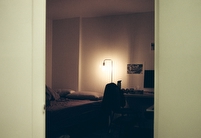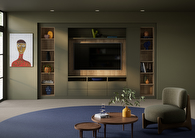
How to refresh your teen's bedroom
Your teenage years are hugely transformational, and it's a time of rapid change.


If you're looking to decorate your bedroom using the Japandi style trend this spring, follow these tips to achieve the best Japandi bedroom possible.
One of the big interior design trends for 2021 is the Japandi aesthetic – a meeting of Scandinavian and Japanese concepts focusing on the idea of less is more, creating a calming, comfortable atmosphere.
This trend suits those who want a more simplistic approach to their living spaces, especially for rooms like the bedroom where peace of mind is crucial. We’ve explored what Japandi style is and how you can achieve this look to create your own Japandi bedroom by following a handful of key ideas.
Japandi style involves blending together the Scandinavian principle of ‘hygge’ with the Japanese concepts of ‘wabi-sabi’ and minimalism.
Hygge embraces the softer side of clean and clutter-free minimalist styles, bringing in tactile textile accents and colour palettes to maximise any comforting elements present.
Wabi-sabi encourages the appreciation of imperfect and incomplete forms within the everyday, making a room work in harmony with its purpose through choosing simple items that provide beauty through practicality.
Together, they cover the design elements of:
The appeal of this trend rests within its effortless grace and elegance. It can elevate a room, making it a calmer place to be without sacrificing the more comfortable elements.
Starting with the Japandi colour palette for bedroom spaces, you should keep to lighter shades for the majority of the space. Using a backdrop of more neutral tones for your walls, such as whites and creams, creates a clean, inviting atmosphere you can build on. It also allows you to use brighter colours sparingly, achieving a more vibrant space without overwhelming the more relaxing neutral colours.
If you choose to use small splashes of colour, keep to a cohesive use of colour. That means if you’ve chosen to add elements of blue to your bedroom, you should utilise varying shades of darker and lighter blues to avoid creating a stark visual contrast. However, you should mainly focus on natural shades that work well alongside whichever neutral tone you’ve chosen, creating a harmonious bedroom environment that doesn’t distract the eye.
If you do wish to stray a little further outside of traditional minimalism, you can incorporate a small number of monochromatic or metallic elements. This could be something like gold pattern work on a plant pot or a simple matte black table lamp. So long as you’re not creating an excessive amount of visual noise, experimentation can make the space feel more personal.
A key design element that Japandi style makes full use of is natural materials for its furnishings. Wabi-sabi is primarily centred around the appreciation of imperfect form in nature, such as the grain patterns within wood and the surfaces of stone.
For those who’d rather avoid introducing colourful touches, this is where your creativity and personal touches can shine through. Furnishings made from materials such as wood or wicker with woven textile covers will enhance the calmer atmosphere you’ve brought in through using neutral colours. Wooden bedframes with simple structures would be the ideal choice for a Japandi bedroom, with emphasis on quality craftsmanship. There’s also the option to add a bit of the natural world into the indoors by selecting the ideal houseplants for your bedroom space.
When selecting elements which provide some homely touches, such as bowls, lamp shades and plant pots, you can add subtle nuances by exploring a range of natural materials. Dark stone bowls on a light wooden table, cream paper lampshades or wicker-topped wooden seats can give you room to find your own interpretation of Japandi style.
As mentioned previously, Japandi style incorporates minimalist concepts. This comes through in the selection of storage furnishings, keeping clutter tidied away in a dedicated space and having your cupboards or wardrobes stay true to form. Simplicity is key, so your choices don’t need ornate patterns or designs.
Pick bedroom furniture that matches your practical needs, giving you enough space to provide your clothes, jewellery and other things with a home. Fitted wardrobes and recessive storage solutions can provide you with the space you need without overwhelming a room with bulky furnishings. Keep your floors and surfaces clear of unnecessary items, retaining just the things you need and one or two decorative touches if desired.
The final soft furnishings you add to your Japandi bedroom are what brings everything together, ensuring the space feels welcoming and comforting. Thick, knitted blankets with interesting patterns, woven rugs and seersucker bedding can add subtle, tactile patterns that soften the overall feel of your bedroom.
Not only will they fit with the Japandi colour palette and visual style you’ve constructed, but they are also practical additions to your bedroom. Adding textiles with woven patterns can interact well with the natural materials of your furnishings, creating a cosy environment that’s conducive to relaxation and sleep.
Feel like your bedroom could use an overhaul into the Japandi style but need some more of these key elements to work with? Why not book a design visit with one of our design experts to see how we can weave some Japandi style into your space? If you’d rather scout out options yourself, you could always request a brochure to check out the minimalist built-in storage solutions we can offer.

Your teenage years are hugely transformational, and it's a time of rapid change.

Set a precedent for the new year by decluttering your home using tips from our experts.

Inspired by nature and rooted in calm, grounding tones, the earthy living room trend is all about bringing the warmth and serenity of the outdoors into your living space.
Whether you have an exact vision in tow, or are just at the beginning stage of your home renovation, we have heaps of inspiration for you to get stuck into.
Find a wealth of design tips, trends and inspiration in the pages of our brochure, magazine and on our blog. Our experts are always ready to help you create dream home, pop in store or book your free design visit for experts to help on bringing your vision to life.